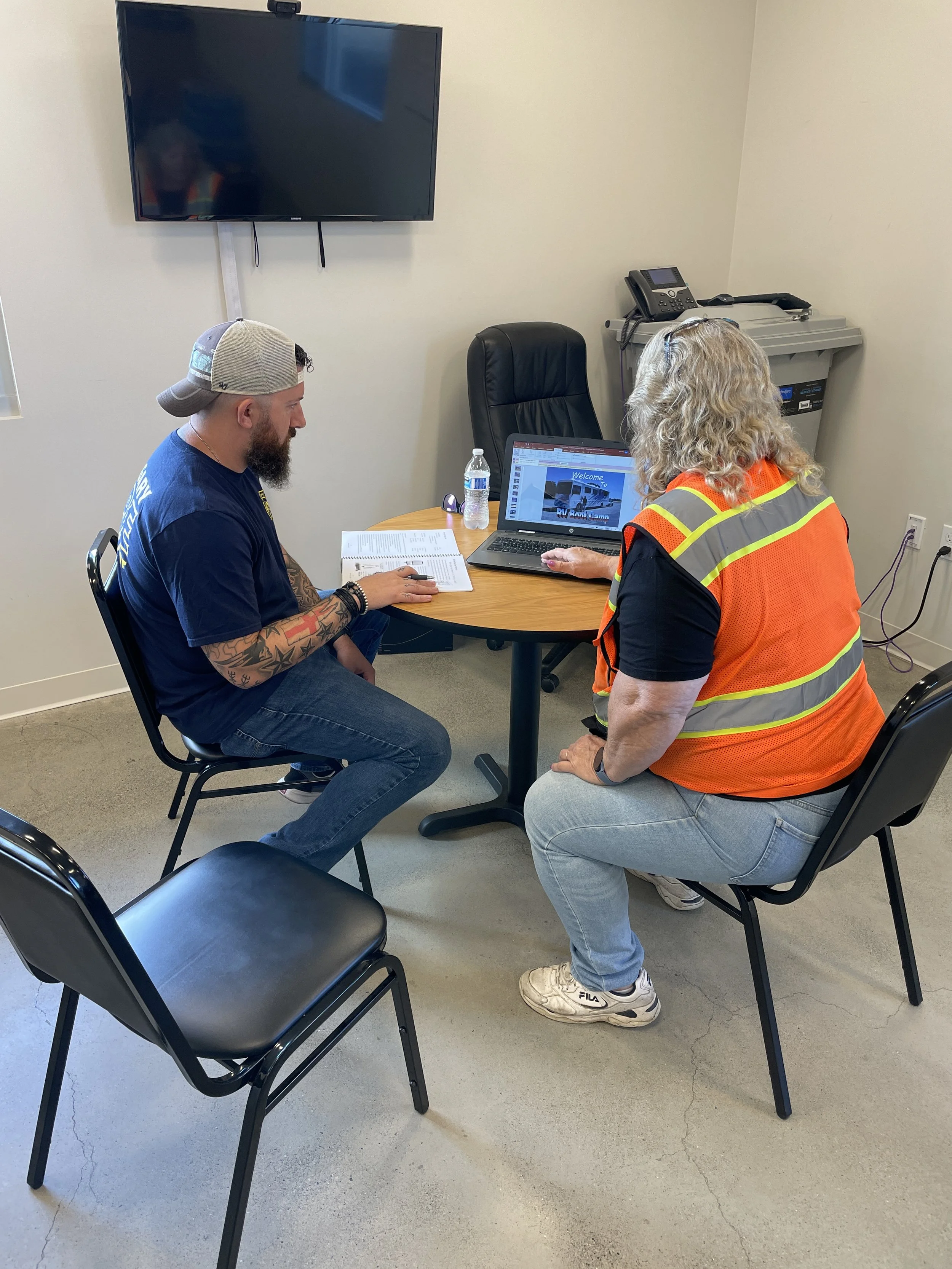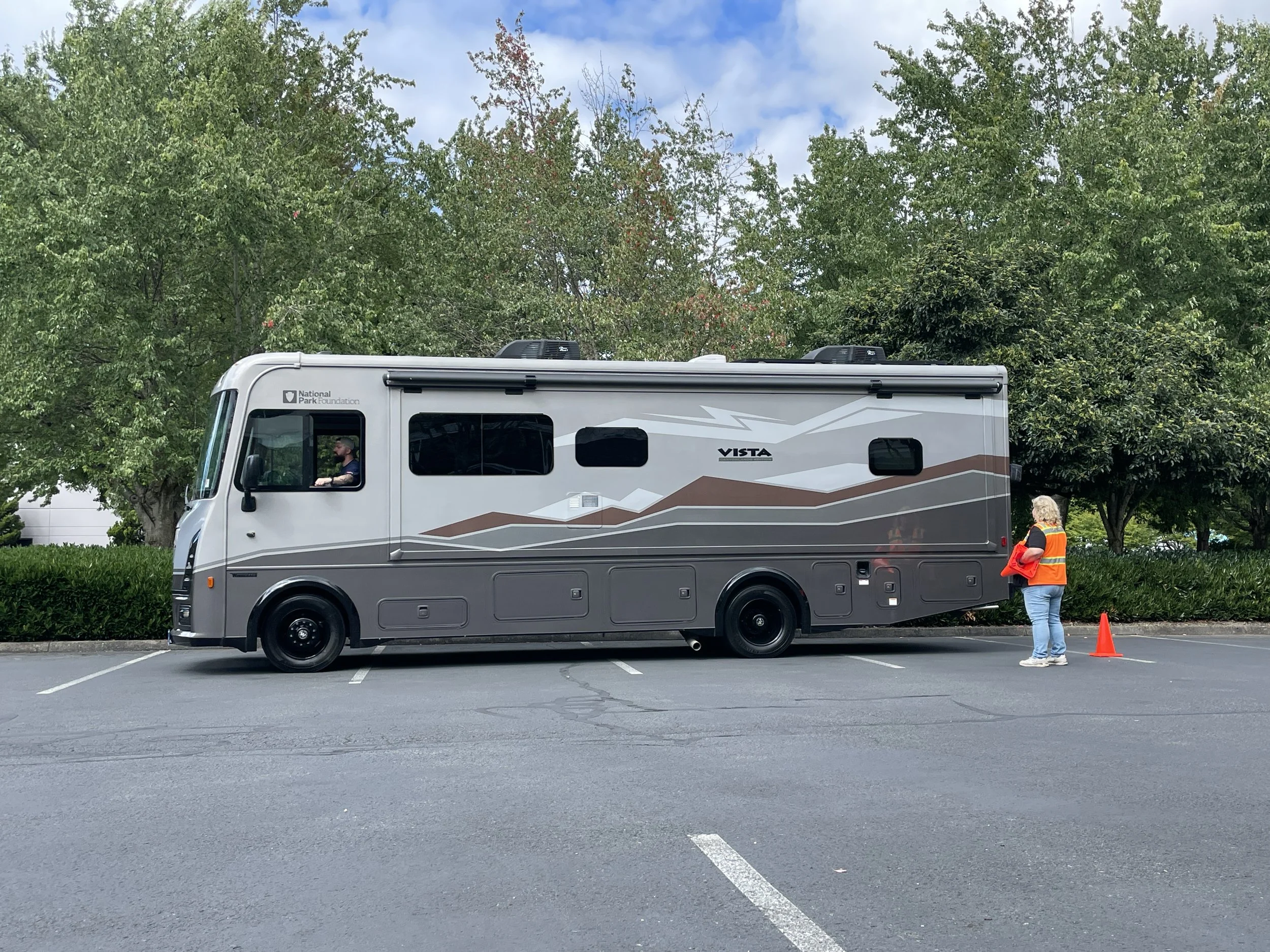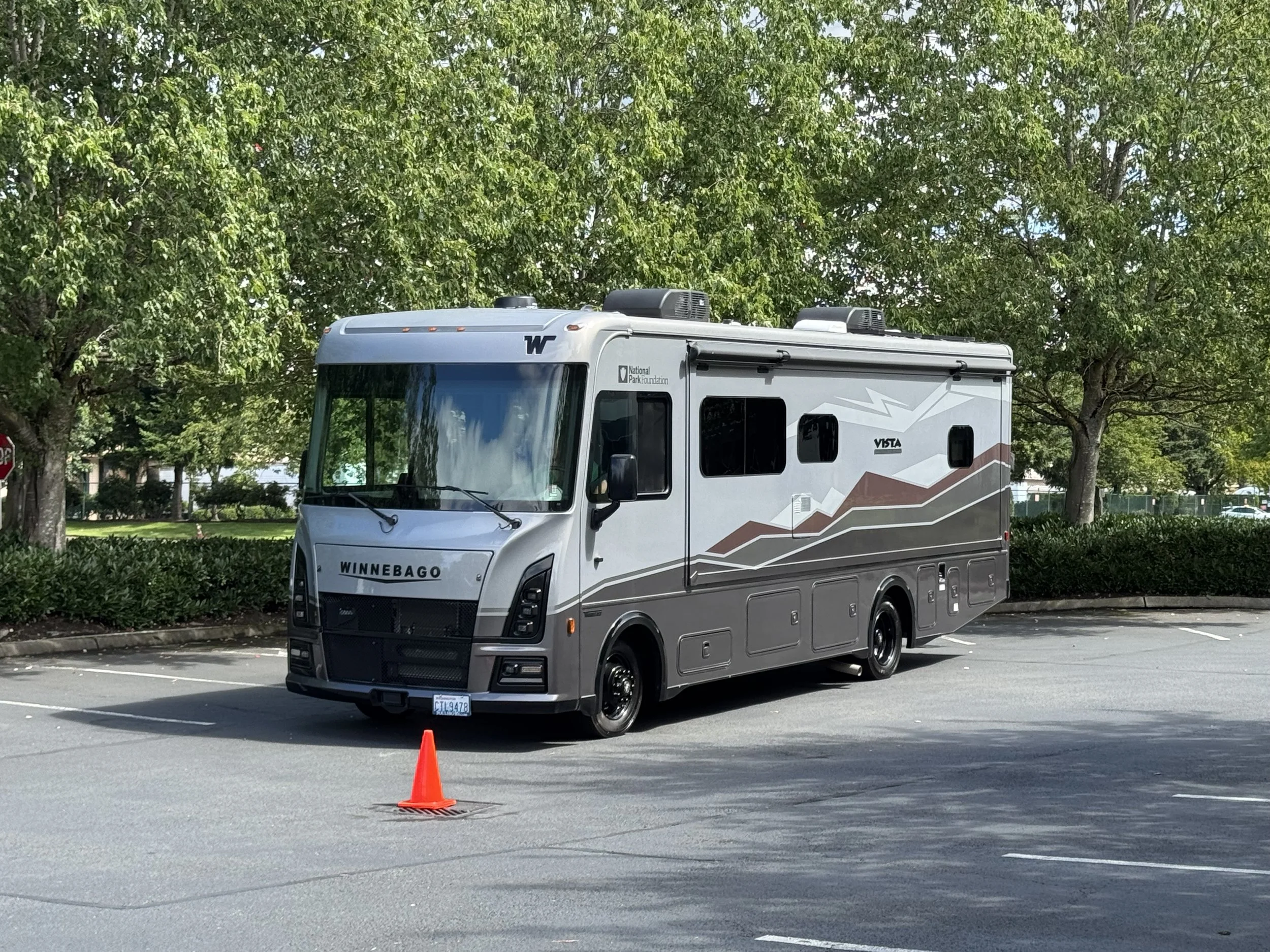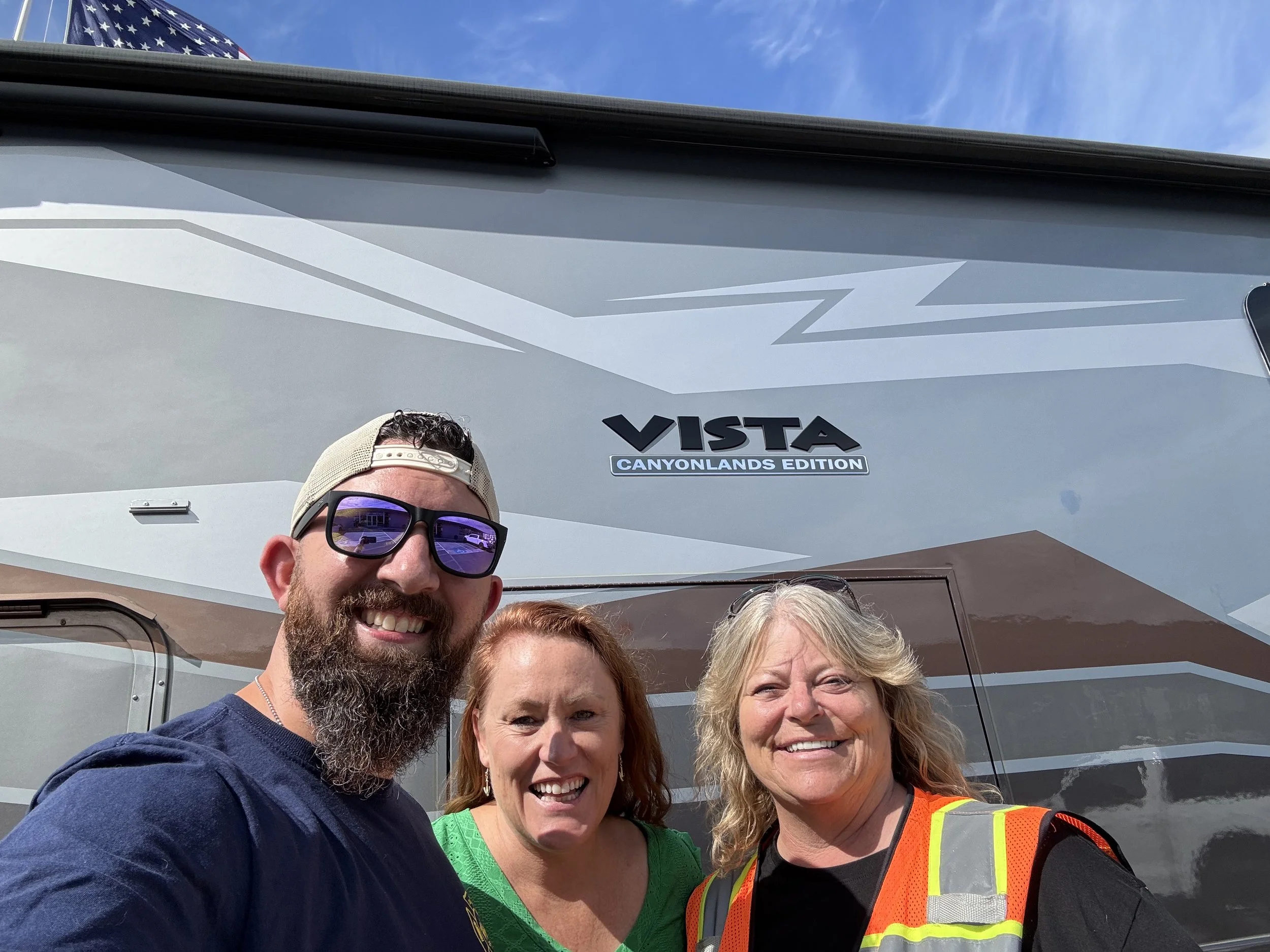Swing Wide or Stay Home: Our First RV Driving Story
So things are moving fast! We’ve got the dream, picked out our house on wheels to fuel it… but then reality set in: how do we actually drive this thing? Neither of us has piloted a 30-foot moving house before—unless you count military convoys, where there was always a team of people involved (and usually a lot more yelling). Luckily, we’re self-aware enough to know that just hopping behind the wheel and “winging it” probably wasn’t the safest plan—for us or for anyone sharing the highway.
Enter Tammie, a 20+ year bus driver and instructor from RV Basic Training LLC, based out of Olympia, WA! We booked a full day with her, and she met us right at the RV dealership to make sure we didn’t embarrass ourselves (or cause property damage) the second we pulled off the lot.
Naturally, training started the way all good training does for military vets—with a PowerPoint. But unlike the many death-by-slideshows we’ve endured in uniform, this one was surprisingly lively. Tammie walked us through real-world RV scenarios, cracked jokes, and made it actually worth staying awake. In about 45 minutes, we were prepped and armed with not just knowledge, but a handy reference book to take with us. No note-taking panic required.
Then came the real test: hands-on training. Suddenly, it felt like we were teenagers again, nervously about to take our driving exams. Juanita went first, carefully adjusting mirrors, side cameras, and backup cameras—because seeing 200 feet behind you in a bus-sized vehicle is no small task. Once she was dialed in, we rolled out to an industrial park, where acres of empty asphalt waited for us and our inevitable mistakes.
This is where Tammie really shined. She customized the lesson to our RV, teaching us about “reference points” and how what you see in the mirror translates into real turning space. With the help of bright orange cones, we learned when to start a turn, how to safely clear objects, and yes—even how to parallel park a motorhome. (Yes, parallel park. And then do it all in reverse!) We traded places so each of us could see things from behind the wheel as well as from outside the vehicle.
By the afternoon, we graduated from cones and parking lots to the highway. We took our rig up to speed, felt the difference in braking, and got a crash course (figuratively, not literally) in how much more thought it takes to climb hills and slow down in something this size compared to a car.
The verdict? We ended the day with zero damage, zero meltdowns, and nothing but smiles and laughter. What could’ve been a nerve-wracking day turned out to be one of the most fun—and valuable—things we’ve done so far.
If you’re even thinking about an RV—Class A, Class C, or a 5th-wheel—do yourself (and everyone else on the road) a favor and take a training class. You’ll drive smarter, feel way more confident, and as a bonus—you can get a discount on your insurance. That’s what we call a win-win.
Lastly, many folks have asked us if we need a special license to drive an RV. The short answer is NO, but it all depends on what state you’re in and what you’re driving. For the vast majority of recreational vehicles, a standard Class D driver’s license is sufficient. This applies to RVs with a Gross Vehicle Weight Rating (GVWR) under 26,001 pounds, including most Class B and Class C motorhomes and many travel trailers. For instance, Class B RVs typically weigh between 6,000 and 8,000 pounds, and Class C vehicles range from 10,000 to 12,000 pounds, well below the 26,001-pound limit. If towing a trailer, a standard license is usually sufficient as long as the towed vehicle is under 10,000 pounds and the Gross Combined Weight Rating (GCWR) does not exceed 26,000 pounds.
While a Commercial Driver’s License (CDL) is almost never required for personal-use RVs, a few states mandate a non-commercial special license for RVs exceeding certain weight thresholds. The requirements vary by state, often involving a written test and a driving test. These states include:
California: Requires a non-commercial Class B license for motorhomes over 26,000 pounds GVWR or over 40 feet in length. A non-commercial Class A license is needed for towing if the travel trailer exceeds 10,000 pounds GVWR or a fifth-wheel travel trailer exceeds 15,000 pounds.
Maryland: Requires a non-commercial Class B license for single vehicles over 26,000 pounds.
Nevada: Mandates a non-commercial Class B license for single vehicles over 26,000 pounds and a non-commercial Class A license for combined vehicles over 26,000 pounds. An additional “J” endorsement is required to tow a vehicle over 10,000 pounds if the combined weight is less than 26,000 pounds.
New York: Requires a Recreational Vehicle or “R” endorsement for vehicles over 26,000 pounds GVWR or over 40 feet in length.
North Carolina: Requires a non-commercial Class B license for single vehicles over 26,000 pounds and a non-commercial Class A license for multiple vehicles with a combined weight over 26,000 pounds.
Pennsylvania: Requires a non-commercial Class B license for single vehicles or combined vehicles over 26,000 pounds.
Texas: Requires a non-commercial Class B license for single vehicles over 26,000 pounds and a non-commercial Class A license for combined vehicles over 26,000 pounds.
Wyoming: Requires a non-commercial Class B endorsement for RVs over 26,000 pounds and a Class A non-commercial license for vehicles over 26,000 pounds towing over 10,000 pounds.
Driving Your RV Across State Lines
When driving an RV across state lines, the principle of reciprocity generally applies. If you are properly licensed in your home state to operate your RV, that license is typically recognized in all other states. This means you are usually subject to the licensing laws of your state of residence, not necessarily the state you are driving through. For example, if your home state does not require a special license for your RV’s weight, you can generally drive it in other states without obtaining additional licenses. While your home state license is valid, you must still adhere to the traffic laws, speed limits, and road regulations of the state you are currently in.




